The global metal packaging market is valued at USD 145.2 billion in 2025 and is set to reach USD 238.7 billion by 2035, recording an absolute increase of USD 93.5 billion over the forecast period. This translates into a total growth of 64.4%, with the market forecast to expand at a CAGR of 5.1% between 2025 and 2035. The market size is expected to grow by approximately 1.6X during the same period, supported by increasing demand for durable packaging solutions, growing beverage industry expansion, rising adoption of canned food products, and expanding requirements for protective packaging across food processing, pharmaceutical, and industrial sectors.
Between 2025 and 2030, the metal packaging market is projected to expand from USD 145.2 billion to USD 186.3 billion, resulting in a value increase of USD 41.1 billion, which represents 44.0% of the total forecast growth for the decade. This phase of development will be shaped by increasing demand for beverage packaging, rising convenience food consumption enabling metal container formats, and growing availability of customizable packaging solutions across food processing operations and specialty industrial applications.
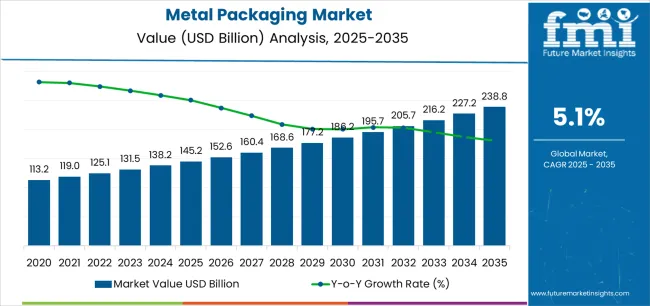
Between 2030 and 2035, the market is forecast to grow from USD 186.3 billion to USD 238.7 billion, adding another USD 52.4 billion, which constitutes 56.0% of the ten-year expansion. This period is expected to be characterized by the advancement of lightweight metal technologies, the integration of smart coating systems for enhanced protection, and the development of premium packaging formats across diverse product categories. The growing emphasis on product preservation and safety principles will drive demand for advanced metal varieties with enhanced barrier properties, improved corrosion-resistant features, and superior functionality characteristics.
| Metric | Value |
|---|---|
| Estimated Market Value (2025E) | USD 145.2 Billion |
| Forecast Market Value (2035F) | USD 238.7 Billion |
| Forecast CAGR (2025-2035) | 5.10% |
From 2030 to 2035, the market is forecast to grow from USD 186.3 billion to USD 238.7 billion, adding another USD 52.4 billion, which constitutes 56.0% of the ten-year expansion. This period is expected to be characterized by the advancement of recyclable metal technologies, the integration of tamper-evident closure mechanisms for security applications, and the development of specialized packaging systems for industrial formulations. The growing emphasis on product presentation and premium positioning will drive demand for sophisticated varieties with enhanced aesthetic appeal, improved stackable design features, and superior performance characteristics.
Between 2020 and 2024, the metal packaging market experienced significant growth, driven by increasing awareness of product safety benefits and growing recognition of metal systems' effectiveness in supporting efficient product preservation across commercial and industrial segments. The market developed as users recognized the potential for metal packaging to deliver economic advantages while meeting modern requirements for minimal product contamination and reliable storage practices. Technological advancement in closure mechanism design and container engineering began emphasizing the critical importance of maintaining airtight operation while extending product freshness and improving user experience across diverse packaging applications.
Market expansion is being supported by the increasing global demand for durable packaging solutions and the corresponding shift toward protective container formats that can provide superior product protection while meeting user requirements for temperature stability and contamination-free storage processes. Modern businesses are increasingly focused on incorporating packaging systems that can enhance brand differentiation while satisfying demands for consistent, reliably performing mechanisms and optimized product handling practices. Metal packaging's proven ability to deliver secure storage, extended product freshness, and diverse application possibilities makes them essential packaging components for food processors and quality-conscious manufacturers.
The growing emphasis on product integrity consciousness and protective packaging is driving demand for high-performance metal packaging systems that can support premium positioning and comprehensive protection benefits across beverage products, canned goods, and industrial product categories. User preference for packaging mechanisms that combine functional excellence with aesthetic appeal is creating opportunities for innovative implementations in both traditional and emerging packaging applications. The rising influence of e-commerce platforms and modern distribution infrastructure is also contributing to increased adoption of metal packaging that can provide secure transportation and reliable functionality characteristics.
The market is segmented by material type, product type, capacity, end-use application, and region. By material type, the market is divided into aluminum packaging, steel packaging, tinplate packaging, and specialty metal packaging. Based on product type, the market is categorized into cans, containers, closures, drums, and aerosol packaging. By capacity, the market includes small (up to 500ml), medium (500ml-1L), large (1L-5L), and industrial (above 5L). By end-use application, the market encompasses food & beverages, personal care, pharmaceuticals, industrial, and other applications. Regionally, the market is divided into North America, Europe, Asia Pacific, Latin America, Middle East & Africa, and other regions.
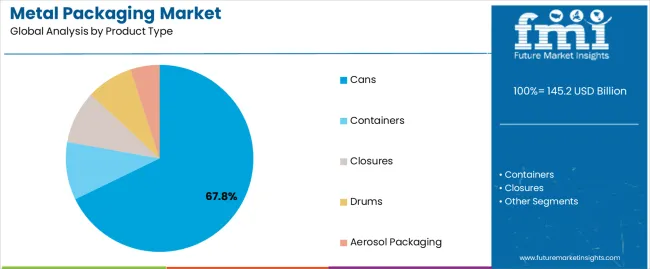
The cans segment is projected to account for 67.8% of the metal packaging market in 2025, reaffirming its position as the leading product category. Businesses and manufacturing facilities increasingly utilize metal cans for their superior durability characteristics, established cost-effectiveness, and essential functionality in diverse packaging applications across multiple product ranges. Metal cans' standardized protection characteristics and proven reliability directly address user requirements for consistent product storage and optimal packaging value in commercial applications.
This product segment forms the foundation of modern packaging patterns, as it represents the format with the greatest commercial versatility and established compatibility across multiple product types. Business investments in design refinement and quality standardization continue to strengthen adoption among performance-conscious operators. With users prioritizing barrier protection and temperature control, metal cans align with both functional objectives and economic requirements, making them the central component of comprehensive packaging strategies.
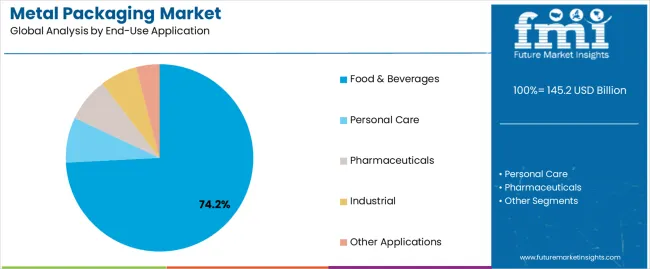
Food & beverages are projected to represent 74.2% of the metal packaging market in 2025, underscoring its critical role as the primary application for efficiency-focused businesses seeking superior product handling benefits and enhanced operational convenience credentials. Commercial users and brand manufacturers prefer food & beverage applications for their established high-volume positioning, proven operational acceptance, and ability to maintain exceptional storage profiles while supporting diverse product offerings during various distribution experiences. Positioned as essential applications for discerning operators, food & beverage offerings provide both operational efficiency excellence and cost-effective advantages.
The segment is supported by continuous improvement in packaging technology and the widespread availability of customization options that enable brand distinction and premium positioning at the consumer level. Packaging companies are optimizing metal designs to support product preservation and accessible distribution strategies. As packaging technology continues to advance and consumers seek convenient storage formats, food & beverage applications will continue to drive market growth while supporting operational efficiency and customer satisfaction strategies.
The metal packaging market is advancing rapidly due to increasing beverage consumption demand and growing need for preservation mechanisms that emphasize superior product protection outcomes across food processing segments and industrial applications. The market faces challenges, including complexity in material selection, compatibility issues with certain product formulations, and cost pressures affecting premium packaging adoption. Innovation in lightweight metal systems and smart coating technologies continues to influence market development and expansion patterns.
The growing adoption of metal packaging in beverage industry packaging is enabling businesses to develop distribution patterns that provide distinctive barrier-protection benefits while commanding consumer confidence and enhanced storage reliability. Beverage applications provide superior preservation properties while allowing more sophisticated sealing features across various product categories. Users are increasingly recognizing the functional advantages of metal packaging positioning for secure product storage and efficiency-conscious logistics integration.
Modern metal packaging manufacturers are incorporating advanced lightweight technologies, enhanced coating concepts, and high-performance material systems to improve operational efficiency, reduce transportation costs, and meet commercial demands for optimized packaging performance. These systems improve resource effectiveness while enabling new applications, including premium product programs and specialized packaging solutions. Advanced coating integration also allows manufacturers to support enhanced protection positioning and performance objectives beyond traditional packaging operations.
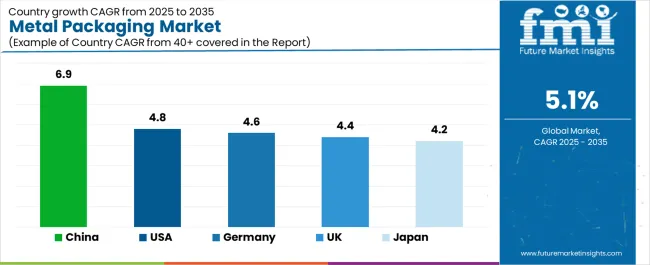
| Country | CAGR (2025-2035) |
|---|---|
| USA | 4.8% |
| Germany | 4.6% |
| UK | 4.4% |
| China | 6.9% |
| Japan | 4.2% |
The metal packaging market is experiencing robust growth globally, with China leading at a 6.9% CAGR through 2035, driven by the expanding manufacturing industry, growing urbanization consumption, and increasing adoption of packaged products. The USA follows at 4.8%, supported by rising beverage demand, expanding food processing applications, and growing acceptance of innovative packaging solutions. Germany shows growth at 4.6%, emphasizing established manufacturing capabilities and comprehensive industrial innovation. The UK records 4.4%, focusing on premium packaging and retail sophistication. Japan demonstrates 4.2% growth, prioritizing quality packaging solutions and technological precision.
The report covers an in-depth analysis of 40+ countries, with top-performing countries are highlighted below.
Revenue from metal packaging consumption and sales in the USA is projected to exhibit exceptional growth with a CAGR of 4.8% through 2035, driven by the country's rapidly expanding beverage sector, favorable consumer attitudes toward durable packaging, and initiatives promoting innovative packaging mechanisms across major manufacturing regions. The USA's position as a leading industrial market and increasing focus on premium packaging development are creating substantial demand for high-quality metal packaging in both commercial and specialty markets. Major beverage companies and food processors are establishing comprehensive packaging capabilities to serve growing demand and emerging market opportunities.
Demand for metal packaging products in Germany is expanding at a CAGR of 4.6%, supported by rising packaging sophistication, growing industrial requirements, and expanding manufacturing infrastructure. The country's developing technical capabilities and increasing commercial investment in precision engineering are driving demand for metal packaging across both imported and domestically produced applications. International packaging companies and domestic manufacturers are establishing comprehensive operational networks to address growing market demand for quality packaging and efficient protection solutions.
Sale of metal packaging products in the UK is projected to grow at a CAGR of 4.4% through 2035, supported by the country's mature industrial market, established manufacturing culture, and leadership in packaging innovation. Britain's sophisticated industrial base and strong support for premium packaging are creating steady demand for both traditional and innovative metal packaging varieties. Leading manufacturing brands and specialty producers are establishing comprehensive operational strategies to serve both domestic markets and growing export opportunities.
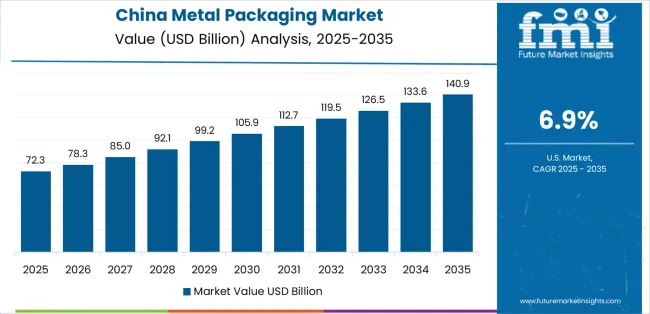
Revenue from metal packaging products in China is expected to expand at a CAGR of 6.9% through 2035, driven by the country's emphasis on industrial expansion, manufacturing leadership, and sophisticated production capabilities for packaging requiring specialized precision varieties. Chinese manufacturers and product brands consistently seek commercial-grade packaging that enhances product protection and supports distribution operations for both traditional and innovative consumer applications. The country's position as an Asian manufacturing leader continues to drive innovation in specialty metal packaging applications and commercial production standards.
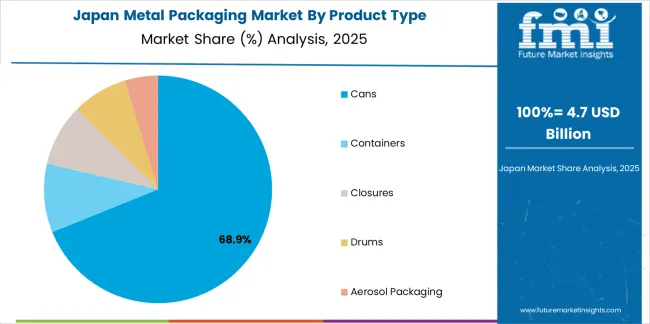
Demand metal packaging products in Japan is anticipated to grow at a CAGR of 4.2% through 2035, supported by the country's emphasis on quality manufacturing, packaging precision, and advanced technology integration requiring efficient packaging solutions. Japanese businesses and product brands prioritize packaging reliability and manufacturing precision, making metal packaging essential protection for both traditional and modern industrial applications. The country's comprehensive quality excellence and advancing packaging patterns support continued market expansion.
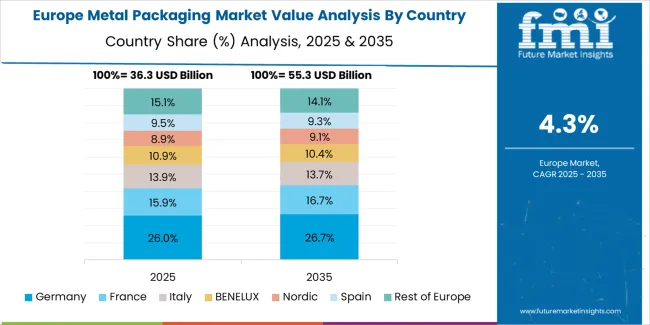
The Europe metal packaging market is projected to grow from USD 47.3 billion in 2025 to USD 76.8 billion by 2035, recording a CAGR of 5.0% over the forecast period. Germany leads the region with a 31.8% share in 2025, moderating slightly to 31.5% by 2035, supported by its strong manufacturing base and demand for premium, technically advanced packaging products. The United Kingdom follows with 22.7% in 2025, easing to 22.3% by 2035, driven by a sophisticated industrial market and emphasis on packaging innovation and design excellence. France accounts for 17.9% in 2025, rising to 18.2% by 2035, reflecting steady adoption of premium packaging solutions and industrial innovation. Italy holds 12.3% in 2025, expanding to 12.6% by 2035 as industrial innovation and specialty packaging applications grow. Spain contributes 7.8% in 2025, growing to 8.1% by 2035, supported by expanding manufacturing sector and premium product handling. The Nordic countries rise from 4.2% in 2025 to 4.5% by 2035 on the back of strong environmental adoption and advanced packaging technologies. BENELUX declines from 3.3% in 2025 to 2.8% by 2035, reflecting market maturity and regional consolidation.
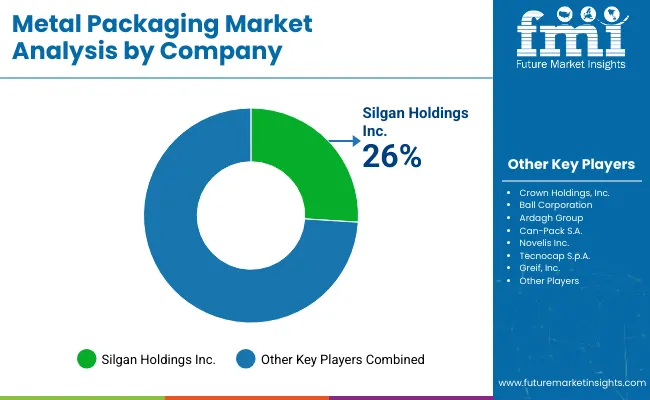
The metal packaging market is characterized by competition among established packaging manufacturers, specialized container producers, and integrated packaging solution companies. Companies are investing in precision forming technologies, advanced coating systems, product innovation capabilities, and comprehensive customization networks to deliver consistent, high-quality, and reliable metal packaging systems. Innovation in lightweight technology, corrosion-resistant materials, and application-specific product development is central to strengthening market position and customer satisfaction.
Crown Holdings Inc. leads the market with a strong focus on packaging innovation and comprehensive protection solutions, offering commercial packaging systems with emphasis on engineering excellence and technological heritage. Ball Corporation provides specialized beverage packaging capabilities with a focus on global market applications and container engineering networks. CCL Industries delivers integrated packaging solutions with a focus on premium positioning and operational efficiency. Silgan Holdings Inc. specializes in comprehensive food packaging with an emphasis on commercial applications. CPMC Holdings Limited focuses on comprehensive industrial and consumer packaging with advanced design and premium positioning capabilities.
The success of metal packaging systems in meeting commercial protection demands, consumer-driven durability requirements, and performance integration will not only enhance industrial delivery outcomes but also strengthen global packaging manufacturing capabilities. It will consolidate emerging regions' positions as hubs for efficient packaging production and align advanced economies with commercial protection systems. This calls for a concerted effort by all stakeholders -- governments, industry bodies, manufacturers, distributors, and investors. Each can be a crucial enabler in preparing the market for its next phase of growth.
How Governments Could Spur Local Production and Adoption?
How Industry Bodies Could Support Market Development?
How Distributors and Industrial Players Could Strengthen the Ecosystem?
How Manufacturers Could Navigate the Shift?
| Item | Value |
|---|---|
| Quantitative Units (2025) | USD 145.2 billion |
| Material Type | Aluminum Packaging; Steel Packaging; Tinplate Packaging; Specialty Metal Packaging |
| Product Type | Cans; Containers; Closures; Drums; Aerosol Packaging |
| Capacity | Small (up to 500ml); Medium (500ml-1L); Large (1L-5L); Industrial (above 5L) |
| End-Use | Food & Beverages; Personal Care; Pharmaceuticals; Industrial; Other Applications |
| Regions | North America; Europe; Asia Pacific; Latin America; Middle East & Africa; Other Regions |
| Key Countries | United States; Germany; United Kingdom; China; Japan; and 40+ additional countries |
| Key Companies | Crown Holdings Inc.; Ball Corporation; CCL Industries; Silgan Holdings Inc. (profiled); CPMC Holdings Limited; Other leading metal packaging companies |
| Additional Attributes | Dollar sales by material type, product type, capacity & end-use; Regional demand trends; Competitive landscape; Technological advancements in packaging engineering; Lightweight technology integration initiatives; Corrosion-resistant coating programs; Premium product development strategies |
The global metal packaging market is estimated to be valued at USD 145.2 billion in 2025.
The market size for the metal packaging market is projected to reach USD 238.8 billion by 2035.
The metal packaging market is expected to grow at a 5.1% CAGR between 2025 and 2035.
The key product types in metal packaging market are cans, containers, closures, drums and aerosol packaging.
In terms of end-use application, food & beverages segment to command 74.2% share in the metal packaging market in 2025.






Full Research Suite comprises of:
Market outlook & trends analysis
Interviews & case studies
Strategic recommendations
Vendor profiles & capabilities analysis
5-year forecasts
8 regions and 60+ country-level data splits
Market segment data splits
12 months of continuous data updates
DELIVERED AS:
PDF EXCEL ONLINE
Competitive Breakdown of Metal Packaging Manufacturers
Metal Aerosol Packaging Market Analysis - Size, Share, and Forecast Outlook 2025 to 2035
Competitive Landscape of Metalized Barrier Film Packaging Providers
Metallized Barrier Film Packaging Market by Material Type from 2025 to 2035
Metal Straw Market Size and Share Forecast Outlook 2025 to 2035
Metal Can Market Size and Share Forecast Outlook 2025 to 2035
Metal IBC Market Forecast and Outlook 2025 to 2035
Metalized Barrier Film Market Forecast and Outlook 2025 to 2035
Metal Bellow Market Size and Share Forecast Outlook 2025 to 2035
Metal based Safety Gratings Market Size and Share Forecast Outlook 2025 to 2035
Metal Modifiers Market Size and Share Forecast Outlook 2025 to 2035
Metallic Stearate Market Size and Share Forecast Outlook 2025 to 2035
Metallic Labels Market Size and Share Forecast Outlook 2025 to 2035
Metal Recycling Market Size and Share Forecast Outlook 2025 to 2035
Metal Forming Fluids Market Size and Share Forecast Outlook 2025 to 2035
Metal Removal Fluids Market Size and Share Forecast Outlook 2025 to 2035
Metal Deactivators Market Size and Share Forecast Outlook 2025 to 2035
Metal Film Analog Potentiometers Market Size and Share Forecast Outlook 2025 to 2035
Metal Oxide Film Fixed Resistor Market Size and Share Forecast Outlook 2025 to 2035
Metal Membrane Ammonia Cracker Market Size and Share Forecast Outlook 2025 to 2035

Thank you!
You will receive an email from our Business Development Manager. Please be sure to check your SPAM/JUNK folder too.
Chat With
MaRIA